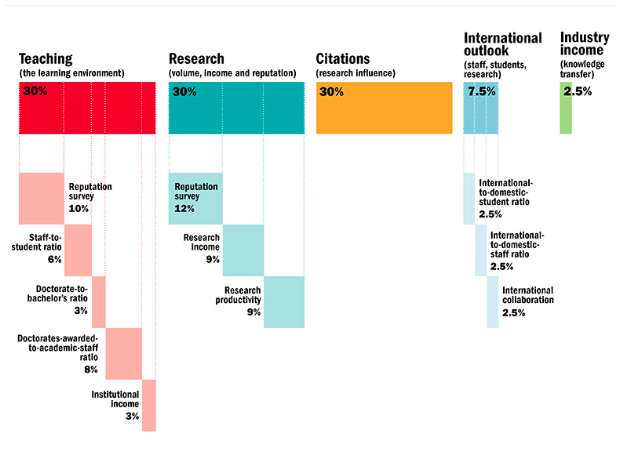 Times Higher Education has launched yet another of their Rankings today. The Young University Rankings use the same methodology used in the World University Ranking (WUR) – also conducted by THE – but recalibrates performance indicators based on goals of young universities.
Times Higher Education has launched yet another of their Rankings today. The Young University Rankings use the same methodology used in the World University Ranking (WUR) – also conducted by THE – but recalibrates performance indicators based on goals of young universities.
Indicators such as reputation, for example, weigh less than in the WUR due to the obvious position of older universities having more advantage in reputability than younger ones.

The results, however, indicate that young universities, particularly , are making their mark on the HE global landscape, as they excel in internationalisation. THE also reports that millennial universities in particular have produced the highest proportion of internationally co-authored research:
Millennial universities generally have low levels of income and research productivity compared with their older counterparts, they are the strongest age group when it comes to producing internationally co-authored research, when compared with “Generation X” (1967-1985) and “Generation Y” (1986-1999) universities, as well the cohort of institutions founded in the immediate aftermath of the Second World War. They also out-perform every other group bar Generation X on citation impact.
The Results of the Top Ten are presented below, with Ecole Polytechnique Federale de Lausanne securing first position. In second place this year, Hong Kong University of Science and Technology overtook Nanyang Technological University.
|
Young University Rank 2017 |
Young University Rank 2016 |
World University Rank 2016-17 |
Institution |
Country |
Year founded |
|
1 |
1 |
=30 |
Switzerland |
1969 |
|
|
2 |
3 |
49 |
Hong Kong |
1991 |
|
|
3 |
2 |
54 |
Nanyang Technological University |
Singapore |
1991 |
|
4 |
5 |
=104 |
South Korea |
1986 |
|
|
5 |
6 |
=89 |
South Korea |
1971 |
|
|
6 |
4 |
94 |
Netherlands |
1976 |
|
|
7 |
20 |
119 |
Hong Kong |
1984 |
|
|
8 |
13 |
=135 |
Germany |
1967 |
|
|
=9 |
8 |
=144 |
Germany |
2009 |
|
|
=9 |
10 |
=190 |
Italy |
1987 |
Many of the names in the top ten will be familiar to those watching the ‘7 fastest-rising young universities in the world‘. Of the seven, only Pompeu Fabra University and Warwick University missed out from the top ten, with the former landing 17th place and the latter no longer eligible for the Rankings as it celebrates its 52nd year (its last appearance was in 9th position in 2015).
In the UK, only four universities made it into the top 100, with the remaining 23 UK HEIs securing positions between 100 and 200.
| Rank | Name |
No. of FTE Students
|
Student:Staff Ratio
|
International Students
|
Female:Male Ratio
|
|---|---|---|---|---|---|
| 16 | University of Dundee | 11,266 | 14.8 | 24% | 61 : 39 |
| 46 | University of Stirling | 8,028 | 15.1 | 20% | 61 : 39 |
| 65 | Plymouth University | 18,508 | 19.5 | 14% | 52 : 48 |
| =98 | University of Portsmouth | 18,949 | 16.5 | 25% | 45 : 55 |
| 101-150 | Bournemouth University | 11,692 | 17.5 | 18% | 57 : 43 |
| 101-150 | De Montfort University | 16,081 | 18.7 | 23% | 58 : 42 |
| 101-150 | Glasgow Caledonian University | 13,733 | 22.1 | 18% | 59 : 41 |
| 101-150 | University of Hertfordshire | 17,552 | 17.7 | 28% | 53 : 47 |
| 101-150 | Liverpool John Moores University | 18,198 | 18.4 | 14% | 53 : 47 |
| 101-150 | Middlesex University | 16,033 | 20.4 | 44% | 60 : 40 |
| 101-150 | Northumbria University | 22,445 | 18.4 | 16% | 55 : 45 |
| 101-150 | The Open University | 70,859 | 34.0 | 9% | 61 : 39 |
| 101-150 | Oxford Brookes University | 12,928 | 17.6 | 27% | 57 : 43 |
| 101-150 | Ulster University | 17,660 | 16.4 | 8% | 56 : 44 |
| 151-200 | University of Bedfordshire | 12,959 | 19.7 | 33% | 58 : 42 |
| 151-200 | Coventry University | 21,285 | 14.7 | 41% | 48 : 52 |
| 151-200 | University of East London | 13,184 | 23.9 | 33% | 60 : 40 |
| 151-200 | University of Huddersfield | 15,033 | 18.3 | 26% | 55 : 45 |
| 151-200 | Kingston University | 18,254 | 22.0 | 35% | 55 : 45 |
| 151-200 | London Metropolitan University | 12,475 | 23.0 | 36% | 61 : 39 |
| 151-200 | Manchester Metropolitan University | 27,326 | 17.7 | 14% | 57 : 43 |
| 151-200 | Nottingham Trent University | 21,932 | 17.0 | 18% | 55 : 45 |
| 151-200 | University of Roehampton | 7,457 | 18.6 | 23% | 73 : 27 |
| 151-200 | University of Salford | 15,610 | 17.0 | 22% | 51 : 49 |
| 151-200 | University of the West of England | 20,754 | 19.7 | 17% | 53 : 47 |
| 151-200 | University of the West of Scotland | 11,593 | 21.5 | 12% | 60 : 40 |
| 151-200 | University of Westminster | 16,568 | 20.2 | 45% | 58 : 42 |
In an article by THE, young universities are seen as being able to quickly adapt to the rapid changes seen globally within the HE landscape in comparison to their traditional competitors, likely due to the established and rooted structures of older universities. However, challenges remain as they need to find their brand and niche in other to ‘build strength in scholarship and research’. Or course, reputation remains key, but many rising stars have demonstrated that building global reputations on the back of high-quality teaching and research environments is possible.